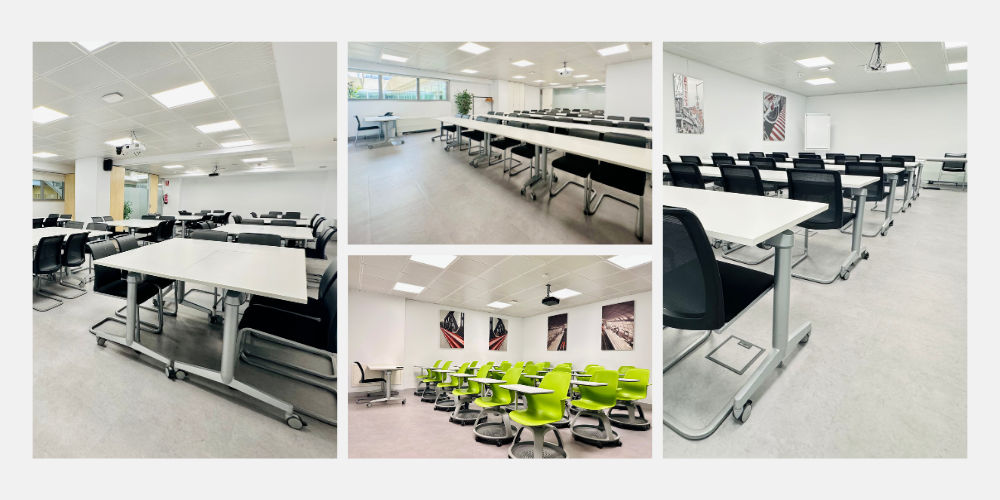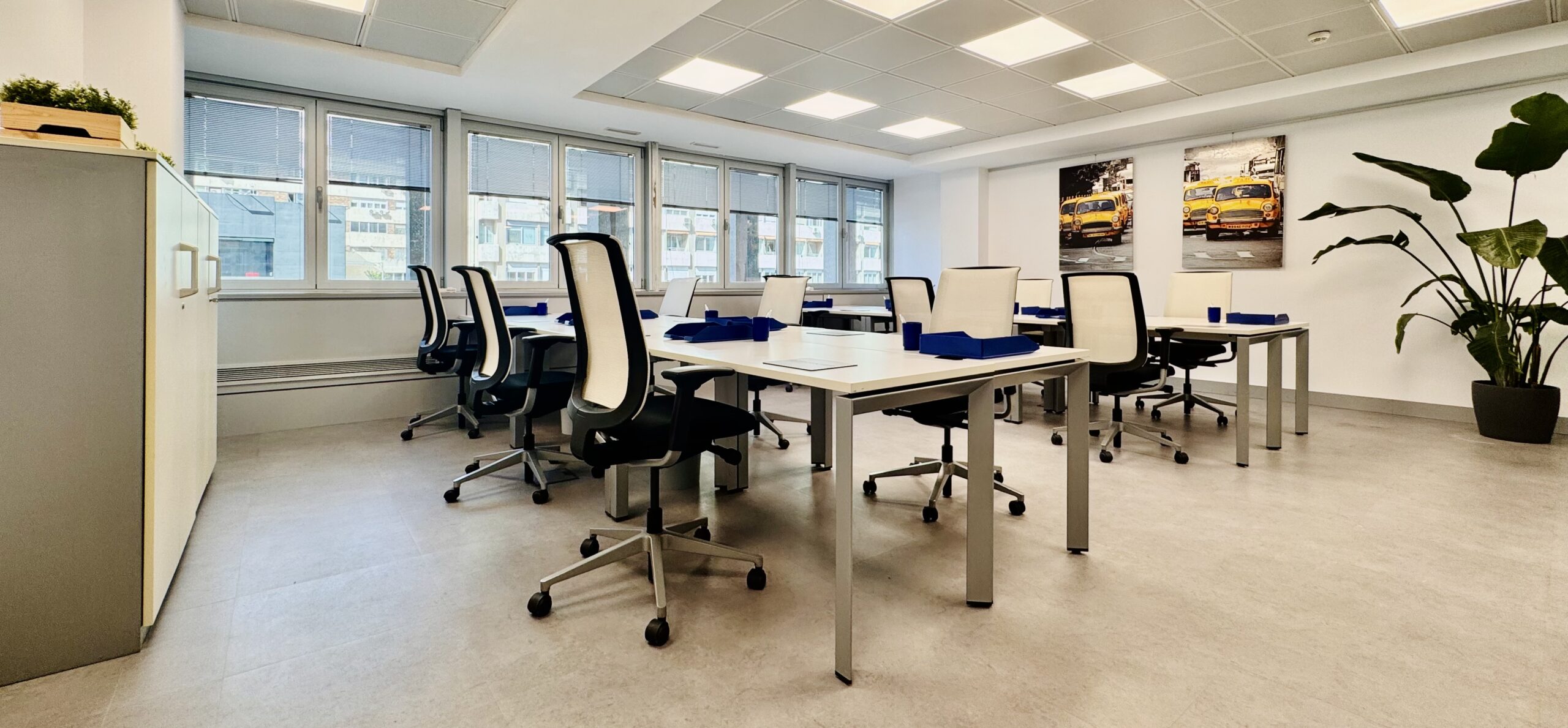Organizar una formación no es simplemente elegir una fecha y convocar a los asistentes. Elegir los espacios para formaciones adecuados puede marcar la diferencia entre una experiencia enriquecedora o un evento que se olvida al día siguiente.
Organizar una formación es como dirigir una película. Tienes el guion (el contenido), los actores (los ponentes) y el público (los asistentes). Pero, ¿dónde se rueda la magia? En la localización. Puedes tener el mejor guion del mundo y a los actores más galardonados, pero si ruedas tu obra maestra en un sótano lúgubre, sin luz y con un proyector que parpadea como una luciérnaga con hipo, la experiencia será un desastre memorable… por las razones equivocadas.
El lugar que escoges no es un simple contenedor. Es el escenario que amplifica tu mensaje, el catalizador que fomenta el aprendizaje y la tarjeta de presentación que grita “somos profesionales” o susurra “improvisamos sobre la marcha”. Para un ejecutivo, que busca impartir un workshop de liderazgo, el espacio debe irradiar autoridad y eficiencia. Para una multinacional en expansión, debe reflejar su prestigio y solidez. Y para una emprendedora, necesita ser un hervidero de inspiración y conexión.
La elección de espacios para formaciones es una decisión estratégica, no logística. Y como en toda buena estrategia, hay que tener un plan. Así que, coge papel y boli (o abre tu app de notas favorita), porque vamos a desgranar los mandamientos sagrados para que tu próxima formación no solo sea buena, sino legendaria.

¿Por qué son tan importantes los espacios para formaciones?
Piénsalo: ¿aprenderías igual en una sala oscura y ruidosa que en una sala luminosa, equipada, con café a mano y buena conexión Wi-Fi?
El entorno de aprendizaje afecta el rendimiento cognitivo, la participación y la retención del conocimiento.
Los buenos espacios para formaciones deben:
- Estimular la concentración.
- Ofrecer confort durante varias horas.
- Estar tecnológicamente preparado.
- Generar un ambiente profesional y acogedor.
En resumen: no es un gasto, es una inversión en resultados.
El decálogo del organizador de formaciones triunfador: 10 tips para elegir los espacios para formaciones ideales
Hemos creado una lista de 10 puntos clave que debes analizar antes de decir “sí, quiero” al primer espacio que encuentres en Google. ¡Vamos allá!
1. Ubicación, ubicación y… ¡sorpresa!, ubicación
No es un cliché, es el pilar fundamental. Un espacio inaccesible es el primer obstáculo para el éxito. Antes de enamorarte de unas fotos espectaculares, pregúntate:
- ¿Es fácil llegar? Piensa en tus asistentes. ¿Vienen en transporte público? ¿Necesitan aparcamiento? Un lugar con buena conexión de metro, varias líneas de autobús y opciones de parking cercano es un gol por toda la escuadra. Para formaciones corporativas, estar en el corazón financiero de Madrid como Azca, en el epicentro comercial y cultural de Gran Vía, o en la distinguida zona de negocios del Barrio de Salamanca, cerca de Velázquez, no solo es práctico, sino que envía un mensaje de prestigio y seriedad.
- ¿Qué hay alrededor? Una formación de un día entero requiere pausas. ¿Hay cafeterías decentes cerca? ¿Restaurantes para la comida? ¿Un parque para estirar las piernas? Un entorno agradable y con servicios mejora la experiencia global de los asistentes.
- ¿Refleja la imagen de mi empresa? Si eres una consultora de alto nivel, una ubicación en un distrito financiero consolidado suma puntos. Si eres una agencia creativa, un barrio vibrante y lleno de vida puede ser más adecuado. La dirección en la invitación ya está comunicando algo sobre ti.
Pro-Tip: No subestimes el “efecto wow” de una dirección prestigiosa. Facilita la vida a tus asistentes y eleva la percepción de tu evento desde el minuto uno.
2. El tamaño (y la forma) sí importan
Has convocado a 20 personas. Encuentras una sala preciosa… para 15. “Bueno, apretujados se conocen mejor”, podrías pensar. ¡Error! Un espacio demasiado pequeño genera agobio, calor e incomodidad, matando la concentración. Uno demasiado grande puede sentirse desangelado y frío, dificultando la interacción.
La clave es la proporción y la versatilidad. Busca espacios para formaciones que ofrezcan diferentes configuraciones:
- Formato Teatro: Ideal para ponencias y presentaciones magistrales. Maximiza la capacidad.
- Formato Escuela: Con mesas y sillas. Perfecto para talleres donde los asistentes necesitan tomar notas o usar portátiles.
- Formato en “U” o Imperial: Fomenta el debate y la participación. Genial para workshops, sesiones de brainstorming o formaciones de equipos directivos.
Asegúrate de que el espacio permita una circulación fluida, que haya sitio para dejar abrigos y mochilas sin que se convierta en una yincana de obstáculos.
Pro-Tip: Pide siempre los planos de la sala con los distintos tipos de montaje posibles y su capacidad máxima para cada una. Una buena empresa de alquiler de espacios te los facilitará sin problema.
3. Tecnología que juegue a tu favor, no en tu contra
Estamos en el siglo XXI. Una formación sin un soporte tecnológico impecable es como un coche sin ruedas: no va a ninguna parte. La lista de imprescindibles es innegociable:
- Wi-fi de alta velocidad: Y no nos referimos a una conexión doméstica que se colapsa con cinco personas. Necesitas una red profesional, estable y potente, capaz de soportar a todos tus asistentes conectados simultáneamente sin despeinarse.
- Equipos audiovisuales de calidad: Un proyector con buena resolución y brillo (que se vea bien incluso sin apagar todas las luces), una pantalla de tamaño adecuado, y un sistema de sonido claro y sin acoples, especialmente para salas grandes.
- Pizarras y flipcharts (rotafolios): ¡No han pasado de moda! Son herramientas vitales para la interacción, el brainstorming y para fijar ideas clave. Asegúrate de que estén en buen estado y que te proporcionen rotuladores que pinten de verdad.
- Extras que suman: ¿Necesitas alquilar ordenadores para los asistentes? ¿Un sistema de videoconferencia para un ponente remoto? Pregunta por estos servicios adicionales, por cierto en Ibercenter ofrecemos todos estos servicios.
Pro-Tip: El día de la formación ya tendrás suficientes nervios. Elige un proveedor que te ofrezca un servicio “todo incluido”, donde la tecnología esté probada y garantizada. Un soporte técnico disponible durante tu evento es un seguro de vida que te evitará un ataque de pánico si algo falla.
4. La atmósfera: el ingrediente secreto del aprendizaje
Los humanos somos seres sensoriales. Un entorno agradable nos predispone a aprender y a participar. Un entorno deprimente nos invita a mirar el móvil y contar los minutos para escapar. Fíjate en:
- Luz natural: Siempre que sea posible, elige salas con ventanas y luz natural. Aumenta la energía, mejora el estado de ánimo y combate la fatiga visual.
- Acústica: ¿La sala tiene eco? ¿Se oye el ruido de la calle o de la oficina de al lado? Una mala acústica obliga al ponente a forzar la voz y a los asistentes a esforzarse para oír, drenando la energía de todos.
- Climatización: Ni una sauna ni un iglú. Un control de temperatura eficiente y silencioso es fundamental para el confort.
- Decoración y mobiliario: No tiene por qué ser un museo de diseño, pero un mobiliario ergonómico, moderno y funcional, junto con una decoración profesional y cuidada, crea un ambiente mucho más propicio para el trabajo y la concentración.
Pro-Tip: Huye de los sótanos sin ventanas y de las salas con moqueta de los años 80. El entorno es una extensión de tu mensaje, ¡cuídalo!
5. Flexibilidad es el nuevo negro
Los tiempos de los contratos de alquiler rígidos y anuales han pasado a la historia, especialmente para necesidades puntuales como las formaciones. Para una startup o para un proyecto específico de una multinacional, la agilidad es oro.
Busca proveedores que te ofrezcan:
- Alquiler por horas, medias jornadas o días completos.
- Cancelación flexible (dentro de unos márgenes razonables).
- Posibilidad de escalar: ¿Y si la formación es un éxito y necesitas una sala más grande para la siguiente edición? Un buen partner te ofrecerá soluciones.
Esta flexibilidad te permite adaptarte a tus necesidades reales sin comprometer grandes recursos ni asumir riesgos innecesarios. Es la solución perfecta para no tener que preocuparte por la logística y centrarte en lo que de verdad importa: el contenido y los asistentes.
6. Los “extras” que te convierten en un anfitrión de lujo
Una formación no es solo lo que pasa dentro de la sala. La experiencia completa es lo que deja un recuerdo imborrable. Aquí es donde los servicios adicionales marcan la diferencia:
- Recepción y acogida: ¿Hay una persona en la recepción para dar la bienvenida a tus asistentes, indicarles dónde está la sala y resolver dudas iniciales? Este detalle profesionaliza enormemente el evento.
- Coffee Break y Catering: Una pausa para el café es un momento crucial para el networking y para recargar pilas. Un buen café, infusiones, agua, zumos y algo de picar (dulce y salado) son un must. Si la formación dura todo el día, poder gestionar un catering de calidad para la comida en el mismo lugar es un plus de comodidad incalculable.
- Zonas comunes agradables: Disponer de un área de descanso o una pequeña cocina donde los asistentes puedan tomarse un respiro fuera de la sala de formación enriquece la experiencia.
Pro-Tip: Un buen servicio de coffee break no es un gasto, es una inversión en la satisfacción y el networking de tus participantes. ¡Nunca subestimes el poder de un buen croissant!
7. El factor humano: soporte antes, durante y después
Puedes tener la mejor sala del mundo, pero si el equipo humano que la gestiona es ineficiente o poco amable, tu experiencia se verá empañada. Evalúa:
- El proceso de reserva: ¿Es fácil y transparente? ¿Responden rápido a tus dudas?
- Soporte in situ: Ya lo mencionamos en el punto de la tecnología, pero es vital. Saber que hay alguien a quien recurrir si necesitas más sillas, si el proyector no se enciende o si necesitas ajustar la temperatura, te da una tranquilidad impagable.
- Actitud proactiva: Un buen equipo no solo reacciona, se anticipa a tus necesidades.
8. Privacidad y confidencialidad: el santuario corporativo
Este punto es especialmente crítico cualquier ejecutivo, y para las empresas en expansión que manejan información sensible. Si tu formación trata sobre la nueva estrategia comercial, resultados financieros o datos confidenciales de clientes, necesitas garantías:
- Salas privadas y exclusivas.
- Entorno profesional y discreto.
No todos los espacios para formaciones son iguales. Los centros de negocios especializados, a diferencia de los espacios de coworking más abiertos, suelen ofrecer este nivel de privacidad y confidencialidad que el mundo corporativo exige.
9. Relación calidad-precio, no solo precio
Es tentador irse por la opción más barata. Pero cuidado, lo barato puede salir muy caro. En lugar de mirar solo la cifra final, analiza el valor que obtienes:
- ¿El precio incluye el Wi-Fi, el proyector, la pizarra y los rotuladores?
- ¿Hay costes ocultos por limpieza o por uso de la cafetera?
- ¿Cuánto tiempo y estrés te ahorra un servicio “todo incluido”?
Un proveedor como Ibercenter, por ejemplo, te ofrece un paquete cerrado. Alquilas uno de nuestros espacios para formaciones en Azca, Gran Vía o Velázquez y sabes que tienes incluida la tecnología de última generación, el mobiliario, la recepción de asistentes y el soporte técnico. Es una propuesta de valor clara que te permite presupuestar sin sorpresas y te libera de la microgestión, permitiéndote enfocarte 100% en tu formación.
Pro-Tip: Compara manzanas con manzanas. Pide un desglose completo de lo que incluye cada presupuesto para evaluar el coste real y el valor que te aporta cada opción.
10. La prueba del algodón: ¡visita el espacio!
Por último, pero no por ello menos importante: siempre, siempre, SIEMPRE, visita el lugar antes de contratarlo. Las fotos pueden ser engañosas. Una visita te permite:
- Sentir la atmósfera del lugar.
- Verificar el estado real del mobiliario y la tecnología.
- Medir las distancias y la accesibilidad real.
- Conocer al equipo que te dará soporte.
Si no puedes ir tú, envía a alguien de confianza. Esta visita es la confirmación final de que estás tomando la decisión correcta.

Conclusión: tu formación merece un escenario a la altura
Elegir los espacios para formaciones adecuados es mucho más que alquilar una sala. Es una inversión en la experiencia de tus asistentes, en la eficacia de tu comunicación y en la imagen de tu marca. Es la diferencia entre una jornada que se olvida al salir por la puerta y una que inspira, motiva y deja una huella duradera.
No te dejes llevar por la prisa ni por el primer resultado de búsqueda. Sigue este decálogo, analiza tus necesidades y las de tus asistentes, busca un partner que entienda que su trabajo es hacerte la vida más fácil.
En Ibercenter, llevamos años creando esos escenarios perfectos. Entendemos que cada formación es única y por eso nuestras salas en las mejores ubicaciones de Madrid están diseñadas para ser flexibles, profesionales y tecnológicamente impecables. Te ofrecemos la tranquilidad de un servicio todo incluido para que tu única preocupación sea brillar.
¿Listo para que tu próxima formación sea un éxito rotundo? Descubre nuestros espacios para formaciones y déjanos ayudarte a construir la experiencia de aprendizaje perfecta.






